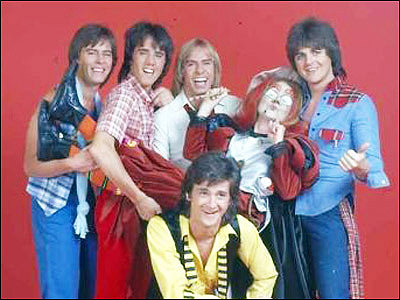Mike Everleth read what I wrote about the show I did for Kroffts with the Bay City Rollers and he has three questions…
1. What was the order of production? Did you do all the season's musical performances in a few days? Then film the Krofft character sequences?
Each show that was produced was made up of about ten different segments — opening musical number, opening monologue, "Horror Hotel" segment, "Lost Island" segment, comedy blackouts with the Rollers, etc. We wrote thirteen of each segment in advance, working out of the offices the Kroffts then had out in the Valley. Then the whole operation moved into offices on the KTLA lot in Hollywood and we began taping and filming.
I don't remember the order these were done but we shot thirteen opening numbers over a day or three, then thirteen monologues over a day or three, then thirteen of this and thirteen of that. Finally, someone — happily, not I — went into an editing room for a couple of weeks and assembled thirteen hour shows which were later cut into thirteen half-hour shows.
2. Was the concert audience there all the time? The opening scene feels like there's no audience, but we do see them later. And why are they seated so far away from the band?
The live audience was brought in for one or two days when we were shooting some of the musical numbers. Footage of the audience was then edited into other musical numbers or material where we wanted the sense of it being done in front of an audience. But a lot of it wasn't. That was pretty standard practice for variety shows then.

Want to hear about one of the easiest jobs I've ever had in show business? The other two writers — Rowby Goren and Lorne Frohman — and I took turns doing the audience hosting for those tapings. Doing "warm-up" for bleachers full of fourteen-year-old girls who were about to see The Bay City Rollers perform was like throwing medium-rare filet mignon out to a band of starving coyotes. At one point, the Stage Manager came over and told me the director had asked me to change the "warm-up" into a "cool-down."
I don't know why the audience wasn't closer. Maybe the guy who designed the set-up was afraid the young ladies there would storm the stage and devour our stars. But I don't think there was as much distance as it appeared on the TV screen.
3. Where was this filmed? On just one set, i.e., was the same spot used for the concert and "Horror Hotel," just dressed differently? Or was there a big soundstage with different sets?
The film stuff with the Rollers running around an amusement park was shot one day at Knott's Berry Farm in Buena Park, not far from Disneyland. There was another day of filming visual gags at a park in Burbank. Everything else was taped on Stage 6 at KTLA where hundreds if not thousands of network and syndicated TV shows were taped.
They set the whole thing up for the musical numbers and we did those. Then over a weekend, they took every bit of that scenery out and installed the sets for "Horror Hotel" and after we shot thirteen of those, those sets disappeared and were replaced by the sets for "Lost Island" and so on.
I worked on several TV shows on Stage 6 there and it was amazing how it could be a dense jungle in there on Tuesday and on Wednesday, they were taping Solid Gold or a game show in there. A lot of the "magic" of television is made by set designers, the tech crew and super-heroes who are referred to as "grips."
I should mention: On Stage 6, we also taped a prime-time special for NBC with the Bay City Rollers and also a syndicated special. These were done after the Saturday morning series so the stage crew had to bring back parts of the concert set and bring back parts of the "Horror Hotel" set and others, and we brought in another live(ly) audience one evening for the music portions of that show.
The NBC one was a done-at-the-last-minute quickie to promote that year's new Saturday morning series and I think we wrote it in three days, taped it in two and delivered it to the network about an hour before it had to air on the East Coast. I did a number of those Saturday morn preview specials — at least one for each of the three major networks then — and they were included in a recent series by the fine writer Andy Mangels, who wrote a multi-part history of such programs for RetroFan magazine.
